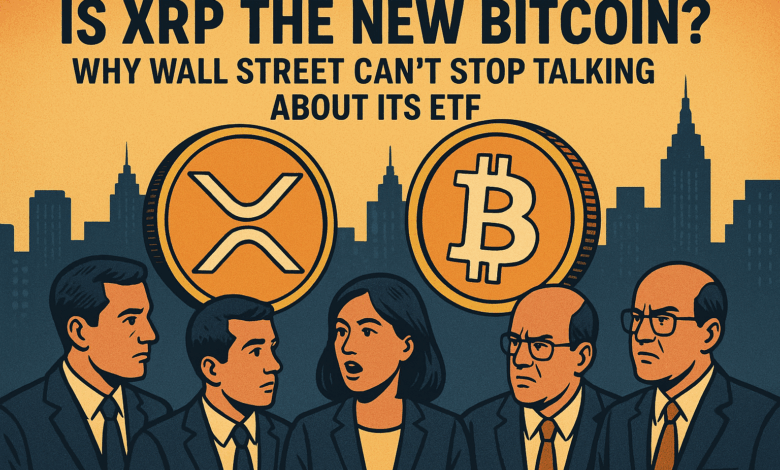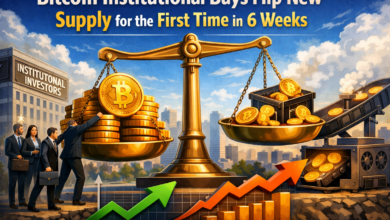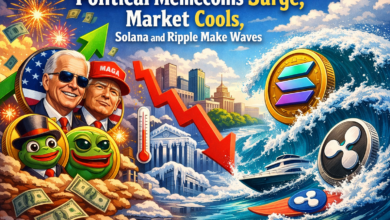Is XRP the new Bitcoin? Why Wall Street can’t stop talking about its ETF

Introduction
Cryptocurrency markets are often driven by sentiment, hype, and occasionally, institutional headwinds. Today, a surprising narrative is taking shape: XRP, long seen as an outsider to Bitcoin (BTC) and Ethereum (ETH), is capturing the attention of Wall Street. While Bitcoin and Ethereum have dominated institutional flows, whispers of an XRP Exchange Traded Fund (ETF) are now circulating, hinting at a potential shift in this trend. XRP’s meteoric rise in relevance may signal that major financial players are looking beyond the usual suspects. With XRP regaining momentum and speculation mounting around ETF potential, the question on the lips of many seasoned investors is whether XRP could emerge as Wall Street’s next big crypto bet.
Understanding the Roots: XRP vs. Bitcoin
Bitcoin (BTC) is the originator of the cryptocurrency revolution. It introduced the world to decentralization, scarcity, and proof-of-work consensus mechanisms. It’s often referred to as “digital gold,” a store of value immune to inflationary monetary policies. Bitcoin’s appeal lies in its decentralized nature, capped supply, and its strong narrative as a haven asset in financial turmoil.
On the other hand, XRP was launched by Ripple Labs with a very different mission—enhancing global financial infrastructure. Designed to facilitate real-time cross-border settlements, XRP boasts transaction speeds of 3-5 seconds and minimal fees. Unlike Bitcoin, XRP is not mined; it was pre-mined with a total supply of 100 billion tokens, with Ripple holding a large percentage to fund development and incentivize network growth. Its underlying consensus algorithm, the XRP Ledger, does not rely on energy-intensive mining, making it faster and more eco-friendly than Bitcoin.
In essence, where Bitcoin offers scarcity and decentralization, XRP provides functionality and efficiency. While Bitcoin is geared toward being a digital alternative to gold, XRP is designed as a bridge currency for cross-border financial institutions. This divergence in vision and application is becoming increasingly significant as institutional investors look to diversify their crypto exposure.
The Growing Importance of ETFs in Cryptocurrency
ETFs, or Exchange-Traded Funds, have reshaped traditional investing, providing retail and institutional investors with easy access to diversified portfolios. When it comes to complex or volatile assets like cryptocurrencies, ETFs serve as a crucial on-ramp. The approval of the first Spot Bitcoin ETF was a historical event—it validated not just Bitcoin, but the broader digital asset class as acceptable within traditional finance circles.
The growing appetite for regulated exposure to crypto assets has led to significant institutional capital entering the sector. A Bitcoin ETF offered a familiar investment vehicle through which pension funds, hedge funds, and retail investors could gain exposure without dealing with the complexities of wallets, keys, and on-chain transactions.
If XRP secures ETF approval in the near future, it would not only elevate the token’s stature but also dramatically improve its liquidity and market reach. Wall Street, traditionally conservative toward emerging technologies, may finally see XRP not as regulatory baggage, but as viable, tradable infrastructure. A regulated ETF would mean massive capital inflows, greater media coverage, and a reshaping of how investors perceive XRP’s long-term value proposition.
Wall Street’s Shifting Perception of XRP
For years, XRP hovered under a cloud cast by regulatory ambiguity, largely due to its prolonged legal skirmish with the U.S. Securities and Exchange Commission (SEC). However, recent legal clarity has shifted the tide. In 2023, Ripple scored a partial legal victory when a U.S. court ruled that XRP isn’t a security in certain contexts—reinstating its availability on top exchanges and re-igniting institutional interest.
Today, Wall Street analysts, fund managers, and institutional investors are revisiting XRP with fresh eyes. Where once skepticism reigned due to lack of clarity and perceived centralization, institutional players are now recognizing XRP’s utility-driven use case. Its ability to settle cross-border transactions within seconds at negligible cost directly addresses many inefficiencies in the global banking infrastructure.
Moreover, XRP’s current price levels present an interesting value proposition. Unlike the high valuations of BTC and ETH, XRP trades at a fraction of the cost, creating a compelling entry point for institutional portfolios seeking high-upside diversification. The confluence of real-world use cases, legal clarity, and low price has made XRP the subject of conversations in boardrooms, trading desks, and strategy sessions across Wall Street.
The Role of the SEC and Regulatory Evolution
The biggest roadblock for XRP’s mainstream adoption has undoubtedly been regulatory. The SEC’s lawsuit against Ripple, accusing it of offering unregistered securities, cast a long shadow over XRP’s future. However, the court’s decision in mid-2023 offered a lifeline. It ruled XRP was not a security when sold on exchanges, though it may be under certain sales models to institutional investors. This nuanced victory was enough to relist XRP on major U.S. exchanges and reignite ETF discussions.
Simultaneously, the regulatory environment for crypto is evolving quickly. New frameworks are being formed at both domestic and international levels, aiming to regulate digital assets without stifling innovation. The SEC, under intense scrutiny and political pressure, may be forced to modernize its approach. Funds eager to launch crypto ETFs—including those based on altcoins—are petitioning for clearer guidance and faster approval mechanisms. XRP now appears well-positioned to benefit from this shift.
Unlike Ethereum, which struggled for years to get ETF consideration due to its transition to proof-of-stake, XRP has had a clearer technological identity from day one. Its consistent operational framework, large user base, and global financial partnerships may finally give regulators confidence in approving an ETF.
XRP’s March Toward Institutional Legitimacy
XRP’s recent reintegration with major exchanges like Coinbase and Kraken is a critical brick in the wall of legitimacy. It allows not only individual investors to trade the asset, but facilitates easier entry for institutional investors using regulated platforms. These developments are far from isolated. In 2023, Ripple signed substantial partnerships with central banks and financial institutions in Asia, Latin America, and Europe, all underscoring XRP’s ambitions in building financial bridges.
From facilitating central bank digital currencies (CBDCs) to serving as the settlement layer for international monetary corridors, XRP is no longer just a cryptocurrency—it is financial infrastructure. An ETF would take this position further, allowing investors to treat XRP not as a speculative asset but as a core holding in next-generation finance portfolios.
This transition—from niche altcoin to institutional-grade asset—is critical. It reshapes XRP’s investment thesis and defines it as a legitimate alternative in the crypto economy. With ETFs serving as the catalyst, XRP could become a foundational piece in diversified digital asset portfolios across the globe.
Conclusion: Why XRP Still Matters
Labeling XRP as “the next Bitcoin” might be a mischaracterization—but that’s exactly what makes it so important. XRP isn’t trying to be the next Bitcoin. It’s not competing to be digital gold. Instead, it’s carving a unique identity as the premier utility-driven crypto asset tailored for a digitized financial ecosystem.
Bitcoin gave the world decentralized value storage; XRP offers global transfer rails. The ETF speculation around XRP is more than a financial product—it is a symbol that institutional finance is ready to build with crypto tools that go beyond speculative assets. If and when XRP gains ETF approval, it will represent a generational validation—Wall Street embracing the multi-faceted nature of crypto assets.
For investors looking to diversify or identify undervalued opportunities, XRP presents a timely option. Traditional finance is beginning to peer beyond Bitcoin, and that journey appears to lead straight to XRP. Don’t be late to the conversation—before the ETF ticker flashes across mainstream terminals, consider revisiting your portfolio. XRP’s story is just beginning to unfold, and if history teaches us anything, it’s that early movers often win the most.
And while you’re positioning for the next big thing, revisit current Bitcoin price prediction trends to see how far the crypto market has progressed. The shift is already underway. The smart money is taking notice. Shouldn’t you?
Source link





